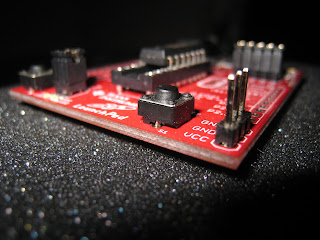Register Mode
mov.w R4,R5 ; move (copy) word from R4 to R6
It is the fastest, with only 1 machine cycle needed.
Any of the 16 registers can be used as source or destination.
Special cases:
- PC - it will be autoincremented before it is used as source
- Both PC and SP must be even, because they are always used as words. so LSB discarded if they are used as destination
- CG2 - it reads 0 as source
- operand is taken from lower byte only
- writing is performed to lower byte only, upper byte is cleared
Indexed Mode
Similar to arrays.
mov.b 3(R5),R6 ; load byte from address 3+(R5) into R6
Here, base address is 3.
Indexing can be used for the source or destination part.
Symbolic Mode (PC Relative)
When PC is used as the base address in the indexed mode, its called symbolic mode by TI. The offset to be added to the PC is given as the constant.
mov.w Loop,R6 ; load word Loop into R6
Assembler replaces this as:
mov.w X(PC),R6 ;
where X = Loop - PC, is the offset in this case. It is caluclated by the assembler, which also performs autoincrementing of PC.
In MSP430, absolute addressing can reach all the memory map. The symbolic mode is mainly meant for MSP430X, etc.
Absolute Mode
This is a special case where the constant in the indexed mode is the absolute address of the data. Since the constant is already the final address, the base must be taken as an address of 0. Usually the SR is selected for this purpose. It behaves as 0 when used as the base, i.e, this is one instance when the SR behaves as a constant generator (CG1).
Absolute addressing is shown by the prefix &.
mov.b P1IN,R6 ; load byte P1IN into R6
It is replaced by the assembler as:
mov.b P1IN(SR),R6 ;
P1IN is the offset, and SR behaves as 0.
SP-Relative
This is not a separate mode in itself. At any time, any value pushed into the stack previously can be accessed, by offseting a suitable amount from the SP. For example:
mov.w 2(SP),R6 ;
Indirect Register Mode
This is available only for the source. It is indicated by the sign @. It means that the contents of a register is used as the address of the operand, i.e, the register contains a "pointer" to the actual operand.
mov.w @R5,R6 ; load word from address pointed to by R5
This is similar to indexed addressing with base address 0. It saves a word of program memory, hence makes it faster.
This mode cannot be used for destination. Using indexed addressing instead:
mov.w R6,0(R5) ; store word from R6 into address 0+(R5)
There is a penalty that a word 0 must be stored in the program memory, and fetched. The constant generator cannot be used.
Indirect Autoincrement Register Mode
This is also available only for the source. It is indicated by a @ in the front, and a + as suffix. Here, the register is used as a pointer as in the indirect register mode. After this, the value in the register is autoincremented by 1 if a byte has been fetched, or by 2 if a word has been fetched.
mov.w @R5+, R6
Since this mode cannot be used for destination, the indexed addressing mode must be used and then explicitly incrementing the value of the register appropriately. Obviously, two instructions would be required.
N.B.
- MSP430 only has postincrement addressing.
- In all the addressing modes, all operations on the first address are fully completed before the second address is evaluated.
Immediate Mode
It is a special case of autoincrement addressing that uses program counter PC. For example:
mov.w @PC+,R6 ;
Here, after the instruction pointed to by PC has been fetched, PC is autoincremented, i.e., PC now points to the next instruction. This particular instruction will be the one copied into R6.

Thank you so much!
ReplyDelete